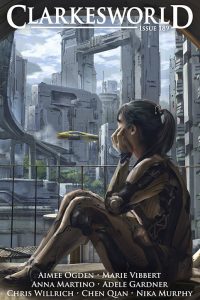Alex Brown and Colleen Mondor Review Written in Starlight by Isabel Ibañez
 Written in Starlight, Isabel Ibañez (Page Street 978-1645671329, $18.99, 368pp, hc) January 2021.
Written in Starlight, Isabel Ibañez (Page Street 978-1645671329, $18.99, 368pp, hc) January 2021.
Written in Starlight begins not long after the chaotic events of Woven in Moonlight, the first book in Isabel Ibañez’s young-adult fantasy duology. Ximena, the fake condesa, and Princess Tamaya remain in the capital as Catalina, the actual condesa, is banished to the jungle where she is expected to die. All Catalina has ever wanted is to take back the throne and rule of Inkasisa as her ancestors did. Now, her last chance is to forge an alliance with the notoriously fierce Illari who live deep in the Yanu Jungle and don’t take kindly to outsiders. As fate would have it, Catalina bumps into Manuel, the presumed lost son of an Illustrian general who has been trapped in the jungle for months. They head for Paititi, the mythical city of the Illari, with the goal of returning to the capital with an army at her back and magic at her fingertips. There in the hidden mountain city, Catalina finds something else instead: herself.
Ibañez’s choice to focus the story on Catalina the colonizer will be a hurdle for some readers. Catalina is a very difficult character to connect to, although I found her compelling. Stubborn to a fault and unwilling to take feedback, she begins the book ostracized by everyone she ever cared for. She believes everyone else is to blame for her circumstances. The throne is her birthright; it is what she is owed, what she is entitled to. She would rather be cast into the jungle where she will surely die than accept that she isn’t the center of the world.
Many, if not most, of the readers of Written in Starlight are colonizers or at least benefit from colonialism. We live in societies that call themselves post-colonial while maintaining colonial power over smaller territories. We sleep on stolen land and turn cultures into mascots and strip resources from their caretakers. We as readers are also trained to think the best of a main character, especially in young adult fiction. Catalina is the heroine. She has to win. Why? Because she’s the main character, that’s why. Catalina expects everyone to root for her and is thoroughly disappointed when no one does. She is a colonizer without a colony. Her attempts to partner with the Illari have nothing to do with helping them reestablish themselves in the lowlands and everything to do with retaking her lost power. She does not want to lead but to rule, to conquer rather than defend, but her entitlement allows her to pretend that her selfish goals are selfless. Ibañez uses Catalina to twist the reader’s expectations and force us to confront our assumptions about privilege and power,
We should ask ourselves why some readers would deem a character like Catalina “unlikeable?” Why do we need a heroine to be “relatable” at all? Why do we build an entire fandom around cishet white male villains who get late-stage redemption arcs without reckoning with their epic violence, while simultaneously shunning and despising a Latina who pushes back against those same tropes? (You know why.)
Written in Starlight sets the reader up to expect Catalina to take back her crown without considering why we want that, or if she even deserves it. Ximena obviously thought she didn’t, or she wouldn’t have made the choices she did in Woven in Moonlight. So where does that leave the reader? Do we believe Ximena or Catalina? What if they are both wrong? Neither girl has thought much beyond how to unite the two people of Inkasisa, the Illustrians and the Llacsans. Except there aren’t two civilizations – there are three. The IIlari lived on the land first and were driven into the jungle by the invading Llacsans, who themselves were driven into the hills by the invading Illustrians. Ximena and Catalina are fighting over who rules the land when really neither people have any real claim on it. They seek to dominate the land while the Illari understand that the land is not theirs to own. Unity cannot occur until all three societies are working together for the benefit of all.
Admittedly, Ibañez’s critique could have been stronger. Some of her authorial choices end up undermining her thesis. Catalina’s redemption comes too late for her to do much in the way of restorative justice and reparations. The magic system is well explained and detailed, but the characters only use it in the simplest of forms and with little effort.
While the story was inspired by Bolivian culture and history, the Illari stuff veers a little too close to Indigenous cultural appropriation for my liking. Furthermore, the duology starts off with the premise that the Illari are everyharmful Native stereotype there is and doesn’t do enough to counteract that. All of the main characters are colonizers in some capacity, and all hold anti-Indigenous beliefs. Catalina does not begin to shed her racist ideologies until after the Illari demonstrate their worth to her mission and her person, meaning all of the work of understanding and reconciliation falls on the oppressed rather than the oppressor. I assume, based on the tone and structure, this was unintentional, but intent does not negate impact.
There is a lot to love about this series. The characters are complex and messy, the plots intriguing and unexpected, the setting fascinating and enticing. Ibañez does a good job of exposing the hypocritical core of colonialism and race-based power structures. This is a young-adult fantasy series, so romance is par for the course, but instead of steamy insta-love we were gifted with slow-burn mutual pining. Love comes, but not until both characters stop defining each other by their hierarchical roles and start seeing each other as people.
Despite all that, I also walked away with some serious concerns about the Indigenous rep. As much as Ibañez was able to call out her characters’ colonialist attitudes, reading Written in Starlight suggests she may have been unaware of her own. It is not my place as a person who is not Indigenous to decide whether the portrayal of the Illari is harmful to that community or not; however, as someone who has several identities that are often written poorly by outsiders, I personally prefer no rep to bad rep. Ultimately, Isabel Ibañez wrote a story that attempts to use a colonizer to deconstruct colonialism. While I don’t think she was very successful at that particular goal (“the master’s tools will never dismantle the master’s house,” as the great Audre Lorde wrote), overall Written in Starlight is a thought-provoking and challenging story.
–Alex Brown
Isabel Ibañez’s Written in Starlight is a companion novel to Woven in Moonlight – not exactly a sequel though it can certainly be read as one. Moonlight was Ximena’s story and Starlight is Catalina’s. They are best friends who are deeply involved in the political drama surrounding the country of Inkasisa where Catalina was the Condesa, destined and determined to rule. Banished to the jungle after a war at the end of Moonlight, her adventure begins in the second book. She wants to get the Inkasisan throne, she needs to persuade the ruler of the remote city of Paititi to help her make war to accomplish that and, more than anything, she has to survive her first night in the jungle. Written in Starlight is about that survival, Catalina’s evolution, a long simmering romance, and some seriously dark magic. The ending ties both books together, thus making it essential reading for Moonlight’s fans.
First and foremost, Catalina is not the most endearing of heroines. Ibañez presents her with all of her arrogance and insecurity, which makes her a protagonist who is quite believable but not particularly lovable. This is okay though, because Catalina is established immediately as a character whose circumstances are forcing her to change. Left in the jungle to fend for herself she is wholly unprepared for a lot of terrifying moments, but the sudden appearance of an old friend, who has been gone on a years-long mission for her kingdom, proves to be a game-changer. Catalina survives, Manuel is back in her life, and she has an actual chance of finding Paititi and thus maybe getting her kingdom back. The sticky problem is that she might have marry the Paititi ruler to get his help, which is a pretty big commitment for a guy you barely know. (Even though he’s a good guy.) But royals do what they must do and if you’re going to wage a war then you marry the guy with the army. And all Catalina wants is to wage that war. Really. For sure.
Except, maybe she doesn’t.
In the midst of a killing virus that is racing through the jungle and attacking the people of Paititi (which involves some limb-ripping moments), Catalina comes to a lot of realizations about what she should be doing with her life. As she lets go of assumptions about her past and her future, she begins to reconsider everything from the throne to her true calling (which might not include the throne). That is the moment that the magic comes to her and everything is clear and Catalina becomes the hero we always suspected she could be.
Written in Starlight is an adventure/coming-of-age novel that happens to take place in an imaginary kingdom (and jungle) that is populated by a lot of familiar (and hungry) animals. The magic, which involves a dark religious twist, is brutal frightening stuff, and Catalina’s journey to stand up to it is far beyond the standard “girl power” narrative. This is a complex group of characters in a gorgeously written setting that sweeps readers away. Ibañez has done an excellent job with these two books and Catalina, like Ximena, is a wonderful, complicated character to spend time with.
–Colleen Mondor
Colleen Mondor, Contributing Editor, is a writer, historian, and reviewer who co-owns an aircraft leasing company with her husband. She is the author of “The Map of My Dead Pilots: The Dangerous Game of Flying in Alaska” and reviews regularly for the ALA’s Booklist. Currently at work on a book about the 1932 Mt. McKinley Cosmic Ray Expedition, she and her family reside in the Pacific Northwest and Alaska. More info can be found on her website: www.colleenmondor.com.
These reviews and more like them in the April 2021 issue of Locus.
 While you are here, please take a moment to support Locus with a one-time or recurring donation. We rely on reader donations to keep the magazine and site going, and would like to keep the site paywall free, but WE NEED YOUR FINANCIAL SUPPORT to continue quality coverage of the science fiction and fantasy field.
While you are here, please take a moment to support Locus with a one-time or recurring donation. We rely on reader donations to keep the magazine and site going, and would like to keep the site paywall free, but WE NEED YOUR FINANCIAL SUPPORT to continue quality coverage of the science fiction and fantasy field.
©Locus Magazine. Copyrighted material may not be republished without permission of LSFF.







